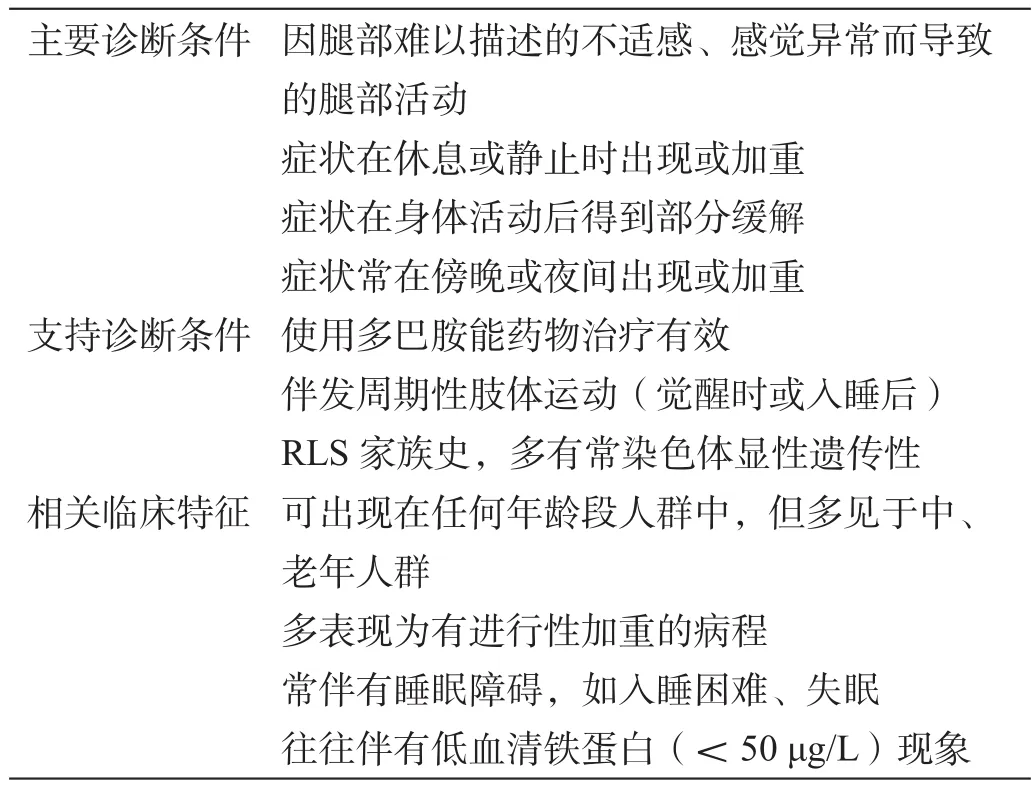多巴胺受体激动剂在治疗不宁腿综合征中的临床应用
2016-01-21喻哲明金莉蓉复旦大学附属中山医院神经内科上海200032
喻哲明金莉蓉(复旦大学附属中山医院神经内科 上海 200032)
多巴胺受体激动剂在治疗不宁腿综合征中的临床应用
喻哲明*金莉蓉**
(复旦大学附属中山医院神经内科 上海 200032)
摘 要不宁腿综合征主要表现为肢体感觉异常及难以控制的肢体活动,多在休息、睡眠时加重而在活动后缓解,患者还常伴有失眠等睡眠障碍。不宁腿综合征的发生与多巴胺能系统异常密切相关,使用左旋多巴和多巴胺受体激动剂治疗有效。其中,多巴胺受体激动剂是治疗不宁腿综合征的一线用药,治疗中、重度不宁腿综合征的疗效较好,患者的耐受性也佳,但长期使用时需注意患者症状加重、反跳等不良反应。
关键词不宁腿综合征 多巴胺受体激动剂 治疗
Clinical application of dopaminergic agonists in the treatment of restless legs syndrome
YU Zheming*, JIN Lirong**
(Department of Neurology, Zhongshan Hospital, Fudan University, Shanghai 200032, China)
ABSTRACTRestless legs syndrome (RLS) is characterized by uncomfortable sensations and irresistible urges to move one’s legs, which is usually worse during the rest or sleep and can be relieved by movement. The pathophysiologic mechanism of RLS may be closely related to dopaminergic system and the use of levodopa and dopaminergic agonists for its treatment is effective, in which the first choice is dopaminergic agonists. Dopaminergic agonists are well tolerant in moderate and severe RLS, however, the adverse reactions such as augmentation and rebound should be taken into consideration in long-term treatment.
KEY WORDSrestless legs syndrome; dopaminergic agonists; treatment
不宁腿综合征(restless legs syndrome, RLS)是一种与睡眠密切相关的感觉运动性疾病,主要表现为腿部或上肢深部的异常不适感觉。这种异常感觉常在休息、睡眠时加重,导致难以控制的肢体活动,但在身体活动后可得到缓解。
Thomas Willis最早于1672年以拉丁文描述了RLS的临床表现。近年来,人们对RLS的病理生理机制有了更深入的认识,发现RLS的发病与多巴胺能系统异常密切相关。2003年Allen等[1]修订的RLS诊断标准提出,RLS的相关临床特征中包括“对多巴胺能药物治疗有反应”。多巴胺受体激动剂是RLS治疗的一线用药,本文就此相关内容作一概述。
1 RLS的发生率及临床特征
RLS在不同国家或地区的发病率不同。在欧美国家人群中,7% ~ 10%的人会出现RLS的核心症状[2-4]。而在亚洲国家,RLS的发病率相对较低,其中在日本为4.6%[5],在中国台湾地区成人中为1.57%[6],在上海地区50岁以上人群中为0.69%[7]。
1995年,国际RLS研究小组(The International Restless Legs Syndrome Study Group, IRLSSG)提出的RLS的核心临床特征为:①由于腿部感觉异常导致腿部活动;②该症状在休息时出现或加重;③该症状会在身体活动后得到部分缓解;④该症状在傍晚或夜间加重[8]。只有同时满足这4项特征才可被诊断为RLS。由于夜间异常的肢体活动,RLS患者还会出现睡眠障碍并因此产生日间思睡和疲倦等症状。严重的RLS患者甚至在白天也可出现难以控制的肢体活动。2003年,IRLSSG更新
了RLS诊断的基本条件、支持条件以及RLS相关的临床特征(表1)[1],其中提到使用低剂量多巴胺能药物可有效缓解RLS的临床症状,并将此作为RLS诊断的支持条件之一。

表1 RLS的诊断条件及相关临床特征
临床诊断RLS时还需与静坐不能和神经根痛等疾病予于区分。有多种原因可导致静坐不能。使用抗精神病药物治疗可出现静坐不能[9],多表现为难以控制的全身活动,与严重RLS的表现类似,但活动后不会缓解。体位性低血压患者久坐后也可能出现“难以控制的肢体活动”,多局限于下肢,且卧位或身体活动后能得到缓解,但一般没有肢体深部的异常感觉。
神经根痛患者也会出现肢体深部的异常感觉,与RLS的表现类似,但还有在神经分布区域内的疼痛、麻木和肌肉萎缩等表现。此外,尽管部分患者在身体活动后可部分缓解异常的感觉症状,但并不会出现“难以控制的肢体活动”,且多巴胺能药物治疗无效。RLS还需与夜间腿部痉挛和下肢静脉曲张等相区分,因这些疾病亦可导致患者出现夜间下肢异常感觉的表现。
2 RLS的治疗药物
RLS可分为原发性和继发性两类。目前,原发性RLS的具体发病机制不明,但有证据表明可能与多巴胺能系统障碍和铁代谢异常密切相关[10]。A11细胞是脊髓内唯一一种多巴胺能神经元,被认为与RLS的发病密切相关[11]。通过刺激A11神经元可减少痛觉[12]。一些功能神经影像学如18F-多巴正电子发射断层扫描术[13]、β-CIT单光子发射计算机断层照像术[14-15]等研究结果也显示,A11神经元的缺失及相关脊髓通路异常可部分解释RLS的病理生理过程。铁的缺乏会通过影响酪氨酸羟化酶而导致多巴胺合成减少。RLS的其他可能的发病机制还包括中枢神经系统神经递质异常、遗传因素、免疫功能障碍和炎症机制等[10]。
继发性RLS多继发于其他疾病如尿毒症、缺铁性贫血、叶酸和维生素B12缺乏、干燥综合征、帕金森病、小纤维神经病、多灶性神经病、腓骨肌萎缩症、代谢病患者以及妊娠妇女中,使用三环类抗抑郁药物、H2受体阻滞剂和镇静剂等也可能导致继发性RLS[16]。发现并控制导致继发性RLS的原因可部分缓解RLS的症状。对部分继发性RLS患者,亦可给予用于原发性RLS的药物治疗。
RLS的主要治疗目标是缓解症状、保持肢体正常功能和提高生活质量,现在临床上使用的治疗药物包括多巴胺能药物和非多巴胺能药物。对间断发作、每晚发作和难治性的RLS治疗,美国RLS基金会医学咨询委员会(Medical Advisory Board of the Restless Legs Syndrome Foundation)已发表相关治疗指南[17],其中肯定了多巴胺能药物的临床作用。
多巴胺能药物包括左旋多巴和多巴胺受体激动剂。左旋多巴早就被用于治疗轻度RLS。2009年中华医学会发表的《不宁腿综合征诊断标准和治疗指南》[16]提出,对间歇发作的RLS患者,可以使用每日半片多巴丝肼或卡左双多巴控释片治疗。每日使用左旋多巴会导致患者出现症状加重、反跳等不良反应。对每晚发作的RLS患者,推荐使用多巴胺受体激动剂治疗[18],具体可选用普拉克索0.125 ~ 1.5 mg/d或罗匹尼罗0.5 ~ 6.0 mg/d。
多巴胺受体激动剂还可分为麦角类和非麦角类两类。美国FDA批准治疗RLS的非麦角类多巴胺受体激动剂有普拉克索、罗匹尼罗和罗替戈汀透皮贴膏[19-20],而培高利特等麦角类多巴胺受体激动剂因可导致心脏瓣膜损害等严重不良反应而未获准治疗RLS。已有多项随机、对照试验(randomized controlled trial, RCT)证实,非麦角类多巴胺受体激动剂治疗RLS有效且耐受性和安全性均较好。
2.1 普拉克索
普拉克索通过刺激多巴胺D2和D3受体而产生多巴胺能效应。美国睡眠协会推荐使用普拉克索治疗中、重度RLS(证据级别:高)[21],Garcia-Borreguero等[22]发表的欧洲RLS治疗指南也指出普拉克索短期治疗RLS有效、长期治疗可能有效。多项短、长期研究结果均支
持普拉克索可有效降低中、重度RLS患者的《国际不宁腿量表》(International Restless Legs Scale, IRLS)评分[23-31]。一项对287例中国患者进行的持续6周的RCT结果显示,普拉克索治疗患者的IRLS评分下降幅度达73.8%(P<0.001),且《患者全面印象》(Patient Global Impression)评分改善幅度也达68.6%(P<0.001)[26]。在一项长期开放性试验中,患者在基线、8和52周时的IRLS评分平均分别为22.3、11.1和4.9分,近86.6%的患者在52周时的IRLS评分下降幅度>50%[31]。荟萃分析表明,普拉克索治疗可较安慰剂平均改善患者的IRLS评分5.96分(95% CI: 4.41 ~ 7.79分)[32]。
2.2 罗匹尼罗
罗匹尼罗是一种强效的多巴胺D2和D3受体激动剂,原被用于治疗帕金森病,2005年又被欧美批准治疗RLS。对5项短期RCT的荟萃分析显示,罗匹尼罗治疗可平均改善IRLS评分4分(95% CI: 2 ~ 6分)[21]。对基线IRLS评分>14分的RLS患者,一项26周的RCT及随后40周的开放性研究结果均显示,罗匹尼罗治疗可较安慰剂显著降低患者的IRLS评分[33]。此外,罗匹尼罗治疗也可改善RLS患者的抑郁心境[34]和生活质量[35]等。
在普拉克索和罗匹尼罗的RCT中,RLS患者对普拉克索和罗匹尼罗治疗的耐受性良好,报告较多(发生率>5%)的不良反应为恶心、头痛、疲劳感、思睡、呕吐、眩晕、失眠和鼻咽炎。目前尚未进行过直接比较普拉克索和罗匹尼罗治疗RLS作用的RCT。但一项间接比较的荟萃分析显示,普拉克索治疗可较罗匹尼罗治疗更显著地降低IRLS评分和提高《临床全面印象——全面改善》(Clinical Global Impression – Global Improvement, CGI-I)评分,同时较少发生恶心、呕吐和眩晕等不良反应[36]。
2.3 罗替戈汀透皮贴膏
罗替戈汀透皮贴膏为选择性的多巴胺D1、D2和D3受体激动剂,可经皮持续释放药物以维持稳定的血药浓度,已被批准用于治疗RLS。2004年报告的一项为期1周的有63例中、重度RLS患者参加的RCT提示,罗替戈汀透皮贴膏治疗能够剂量依赖性地改善患者的症状,其中4.5 mg/d治疗可显著改善患者的IRLS评分(P<0.01)[37]。Oertel等[38]和Trenkwalder等[39]分别进行的为期6周和长达1年的RCT也显示,罗替戈汀透皮贴膏3 mg/d治疗中、重度RLS患者有效,但剂量更大(4 mg/d)却无更大疗效且不良反应更多。罗替戈汀透皮贴膏治疗的常见不良反应主要包括头痛和皮肤局部反应。近期完成的一项长达5年的开放性试验结果显示,早期RLS患者接受罗替戈汀透皮贴膏治疗多会因皮肤局部反应等不良反应而终止治疗,但罗替戈汀透皮贴膏对中、重度RLS患者有稳定的疗效(至少5年内)[40]。
2.4 吡贝地尔(piribedil)
吡贝地尔是选择性多巴胺D2和D3受体激动剂,现尚未被批准用于RLS治疗,但已有治疗RLS有效和安全的研究报告。在一项临床试验中,17例RLS患者分别使用氯硝西泮或吡贝地尔治疗4周,结果提示吡贝地尔治疗组患者的症状改善程度更明显(P<0.01),且不良反应仅为轻度胃肠道反应和心动过速,患者的依从性良好[41]。另一项为期10个月的开放性试验显示,吡贝地尔(25 ~ 100 mg/d)治疗可改善RLS症状[42]。
3 RLS治疗期间的注意事项
在使用多巴胺能药物治疗RLS期间可能出现症状恶化(augmentation)和反跳(rebound)等不良反应,这些不良反应更多见于长期、大量使用左旋多巴治疗的患者,但在多巴胺受体激动剂治疗RLS的研究中亦有类似报告。症状恶化包括5种情况:①与治疗前相比,症状的严重程度加重;②休息时症状发生的潜伏期缩短;③白天发生症状;④症状从下肢发展至上肢、躯干;⑤药效的持续时间缩短[43]。症状恶化的机制可能与中枢神经系统内多巴胺过量相关[44]。高浓度的多巴胺会使多巴胺D1受体兴奋、引起多巴胺D1受体相关疼痛,从而产生周期性的肢体活动。使用小剂量多巴胺能药物后出现症状加重的可能性较小。患者长期使用左旋多巴后出现症状恶化的比例在18% ~ 80%间[10]。普拉克索治疗的症状恶化率为0% ~ 30%,但使用小剂量普拉克索时未见类似报告;罗匹尼罗治疗的症状恶化率在4%左右[33,45]。RLS患者在出现轻度的症状加重后可在白天加用多巴胺能药物,但一旦出现严重的症状加重时则需停用多巴胺能药物而改用非多巴胺能药物[46]。症状反跳多因为使用短效多巴胺能药物所致,在药效减退时出现RLS症状,又称“剂末反跳”。RLS症状反跳多在凌晨出现,此时可临时加用1次短效多巴胺能药物或改用长效多巴胺能药物治疗。
4 结语
除多巴胺能药物外,抗惊厥药物和阿片类药物等治
疗RLS也有一定的疗效。一项荟萃分析提示,抗惊厥药物如加巴喷丁等治疗RLS的有效性已获部分临床试验结果的支持,但仍需得到更多RCT的确认[47]。
参考文献
[1] Allen RP, Picchietti D, Hening WA, et al. Restless legs syndrome: diagnostic criteria, special considerations, and epidemiology. A report from the restless legs syndrome diagnosis and epidemiology workshop at the National Institutes of Health [J]. Sleep Med, 2003, 4(2): 101-119.
[2] Berger K, Luedemann J, Trenkwalder C, et al. Sex and the risk of restless legs syndrome in the general population [J]. Arch Intern Med, 2004, 164(2): 196-202.
[3] Rothdach AJ, Trenkwalder C, Haberstock J, et al. Prevalence and risk factors of RLS in an elderly population: the MEMO study. Memory and Morbidity in Augsburg Elderly [J]. Neurology, 2000, 54(5): 1064-1068.
[4] Hogl B, Kiechl S, Willeit J, et al. Restless legs syndrome: a community-based study of prevalence, severity, and risk factors [J]. Neurology, 2005, 64(11): 1920-1924.
[5] Mizuno S, Miyaoka T, Inagaki T, et al. Prevalence of restless legs syndrome in non-institutionalized Japanese elderly [J]. Psychiatry Clin Neurosci, 2005, 59(4): 461-465.
[6] Chen NH, Chuang LP, Yang CT, et al. The prevalence of restless legs syndrome in Taiwanese adults [J]. Psychiatry Clin Neurosci, 2010, 64(2): 170-178.
[7] Ma JF, Xin XY, Liang L, et al. Restless legs syndrome in Chinese elderly people of an urban suburb in Shanghai: a community-based survey [J]. Parkinsonism Relat Disord, 2012, 18(3): 294-298.
[8] Walters AS. Toward a better definition of the restless legs syndrome. The International Restless Legs Syndrome Study Group [J]. Mov Disord, 1995, 10(5): 634-642.
[9] Agarkar S, Anthony D, Ferrando S. Risk of akathisia associated with atypical antipsychotics [J]. J Neuropsychiatry Clin Neurosci, 2013, 25(1): E46-E47.
[10] Nagandla K, De S. Restless legs syndrome: pathophysiology and modern management [J]. Postgrad Med J, 2013, 89(1053): 402-410.
[11] Ondo WG, He Y, Rajasekaran S, et al. Clinical correlates of 6-hydroxydopamine injections into A11 dopaminergic neurons in rats: a possible model for restless legs syndrome [J]. Mov Disord, 2000, 15(1): 154-158.
[12] Fleetwood-Walker SM, Hope PJ, Mitchell R. Antinociceptive actions of descending dopaminergic tracts on cat and rat dorsal horn somatosensory neurones [J]. J Physiol, 1988, 399: 335-348.
[13] Ruottinen HM, Partinen M, Hublin C, et al. An FDOPA PET study in patients with periodic limb movement disorder and restless legs syndrome [J]. Neurology, 2000, 54(2): 502-504.
[14] Linke R, Eisensehr I, Wetter TC, et al. Presynaptic dopaminergic function in patients with restless legs syndrome: are there common features with early Parkinson’s disease? [J]. Mov Disord, 2004, 19(10): 1158-1162.
[15] Eisensehr I, Wetter TC, Linke R, et al. Normal IPT and IBZM SPECT in drug-naive and levodopa-treated idiopathic restless legs syndrome [J]. Neurology, 2001, 57(7): 1307-1309.
[16] 中华医学会神经病学分会帕金森病及运动障碍学组. 不宁腿综合征的诊断标准和治疗指南[J]. 中华神经科杂志, 2009, 42(10): 709-711.
[17] Silber MH, Ehrenberg BL, Allen RP, et al. An algorithm for the management of restless legs syndrome [J]. Mayo Clin Proc, 2004, 79(7): 916-922.
[18] Trenkwalder C, Hening WA, Montagna P, et al. Treatment of restless legs syndrome: an evidence-based review and implications for clinical practice [J]. Mov Disord, 2008, 23(16): 2267-2302.
[19] Bayard M, Avonda T, Wadzinski J. Restless legs syndrome [J]. Am Fam Physician, 2008, 78(2): 235-240.
[20] Stiasny K, Wetter TC, Trenkwalder C, et al. Restless legs syndrome and its treatment by dopamine agonists [J]. Parkinsonism Relat Disord, 2000, 7(1): 21-25.
[21] Aurora RN, Kristo DA, Bista SR, et al. The treatment of restless legs syndrome and periodic limb movement disorder in adults — an update for 2012: practice parameters with an evidence-based systematic review and meta-analyses: an American Academy of Sleep Medicine Clinical Practice Guideline [J]. Sleep, 2012, 35(8): 1039-1062.
[22] Garcia-Borreguero D, Ferini-Strambi L, Kohnen R, et al. European guidelines on management of restless legs syndrome: report of a joint task force by the European Federation of Neurological Societies, the European Neurological Society and the European Sleep Research Society [J]. Eur J Neurol, 2012, 19(11): 1385-1396.
[23] Winkelman JW, Sethi KD, Kushida CA, et al. Efficacy and safety of pramipexole in restless legs syndrome [J]. Neurology, 2006, 67(6): 1034-1039.
[24] Partinen M, Hirvonen K, Jama L, et al. Efficacy and safety of pramipexole in idiopathic restless legs syndrome: a polysomnographic dose-finding study — the PRELUDE study [J]. Sleep Med, 2006, 7(5): 407-417.
[25] Oertel WH, Stiasny-Kolster K, Bergtholdt B, et al. Efficacy of pramipexole in restless legs syndrome: a six-week,
multicenter, randomized, double-blind study (effect-RLS study) [J]. Mov Disord, 2007, 22(2): 213-219.
[26] Ma JF, Wan Q, Hu XY, et al. Efficacy and safety of pramipexole in Chinese patients with restless legs syndrome: results from a multi-center, randomized, double-blind, placebo-controlled trial [J]. Sleep Med, 2012, 13(1): 58-63.
[27] Inoue Y, Kuroda K, Hirata K, et al. Efficacy, safety and dose-response of pramipexole in Japanese patients with primary restless legs syndrome: randomized trial [J]. Neuropsychobiology, 2011, 63(1): 35-42.
[28] Inoue Y, Hirata K, Kuroda K, et al. Efficacy and safety of pramipexole in Japanese patients with primary restless legs syndrome: a polysomnographic randomized, double-blind, placebo-controlled study [J]. Sleep Med, 2010, 11(1): 11-16.
[29] Ferini-Strambi L, Aarskog D, Partinen M, et al. Effect of pramipexole on RLS symptoms and sleep: a randomized, double-blind, placebo-controlled trial [J]. Sleep Med, 2008, 9(8): 874-881.
[30] Partinen M, Hirvonen K, Jama L, et al. Open-label study of the long-term efficacy and safety of pramipexole in patients with restless legs syndrome (extension of the PRELUDE study) [J]. Sleep Med, 2008, 9(5): 537-541.
[31] Inoue Y, Kuroda K, Hirata K, et al. Long-term open-label study of pramipexole in patients with primary restless legs syndrome [J]. J Neurol Sci, 2010, 294(1-2): 62-66.
[32] Zhang W, Wang Y, Cong SY, et al. Efficacy and tolerability of pramipexole for the treatment of primary restless leg syndrome: a meta-analysis of randomized placebo-controlled trials [J]. Neuropsychiatr Dis Treat, 2013, 9: 1035-1043.
[33] Giorgi L, Asgharian A, Hunter B. Ropinirole in patients with restless legs syndrome and baseline IRLS total scores ≥24: efficacy and tolerability in a 26-week, double-blind, parallelgroup, placebo-controlled study followed by a 40-week openlabel extension [J]. Clin Ther, 2013, 35(9): 1321-1336.
[34] Benes H, Mattern W, Peglau I, et al. Ropinirole improves depressive symptoms and restless legs syndrome severity in RLS patients: a multicentre, randomized, placebo-controlled study [J]. J Neurol, 2011, 258(6): 1046-1054.
[35] Cho YW, Hong SB, Kim do H, et al. The effect of ropinirole on the quality of life in patients with restless legs syndrome in Korea: an 8-week, multicenter, prospective study [J]. J Clin Neurol, 2013, 9(1): 51-56.
[36] Quilici S, Abrams KR, Nicolas A, et al. Meta-analysis of the efficacy and tolerability of pramipexole versus ropinirole in the treatment of restless legs syndrome [J]. Sleep Med, 2008, 9(7): 715-726.
[37] Stiasny-Kolster K, Kohnen R, Schollmayer E, et al. Patch application of the dopamine agonist rotigotine to patients with moderate to advanced stages of restless legs syndrome: a double-blind, placebo-controlled pilot study [J]. Mov Disord, 2004, 19(12): 1432-1438.
[38] Oertel WH, Benes H, Garcia-Borreguero D, et al. Efficacy of rotigotine transdermal system in severe restless legs syndrome: a randomized, double-blind, placebo-controlled, six-week dose-finding trial in Europe [J]. Sleep Med, 2008, 9(3): 228-239.
[39] Trenkwalder C, Benes H, Poewe W, et al. Efficacy of rotigotine for treatment of moderate-to-severe restless legs syndrome: a randomised, double-blind, placebo-controlled trial [J]. Lancet Neurol, 2008, 7(7): 595-604.
[40] Oertel W, Trenkwalder C, Benes H, et al. Long-term safety and efficacy of rotigotine transdermal patch for moderate-tosevere idiopathic restless legs syndrome: a 5-year open-label extension study [J]. Lancet Neurol, 2011, 10(8): 710-720.
[41] 江红, 郑凯, 史庭慧. 吡贝地尔治疗不宁腿综合征的临床研究[J]. 卒中与神经疾病, 2006, 13(6): 363-365.
[42] Evidente VG. Piribedil for restless legs syndrome: a pilot study [J]. Mov Disord, 2001, 16(3): 579-581.
[43] Vetrugno R, Contin M, Baruzzi A, et al. Polysomnographic and pharmacokinetic findings in levodopa-induced augmentation of restless legs syndrome [J]. Mov Disord, 2006, 21(2): 254-258.
[44] Paulus W, Trenkwalder C. Less is more: pathophysiology of dopaminergic-therapy-related augmentation in restless legs syndrome [J]. Lancet Neurol, 2006, 5(10): 878-886.
[45] Winkelman JW, Johnston L. Augmentation and tolerance with long-term pramipexole treatment of restless legs syndrome (RLS) [J]. Sleep Med, 2004, 5(1): 9-14.
[46] Garcia-Borreguero D, Allen RP, Kohnen R, et al. Diagnostic standards for dopaminergic augmentation of restless legs syndrome: report from a World Association of Sleep Medicine-International Restless Legs Syndrome Study Group consensus conference at the Max Planck Institute [J]. Sleep Med, 2007, 8(5): 520-530.
[47] Hornyak M, Scholz H, Kohnen R, et al. What treatment works best for restless legs syndrome? Meta-analyses of dopaminergic and non-dopaminergic medications [J]. Sleep Med Rev, 2014, 18(2): 153-164.
收稿日期:(2014-06-02)
通讯作者:**金莉蓉,副主任医师,主要从事帕金森病等运动障碍的临床和基础研究。E-mail: jinlr99@163. com
作者简介:*喻哲明,住院医师,主要从事帕金森病的临床和基础研究
文章编号:1006-1533(2015)03-0018-05
文献标识码:A
中图分类号:R971.5; R741.05
